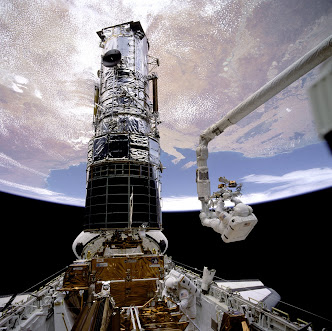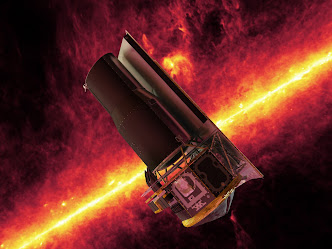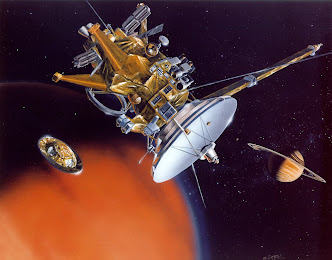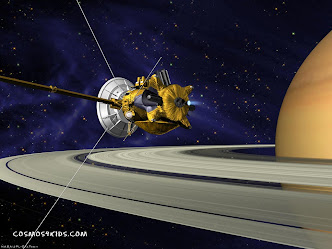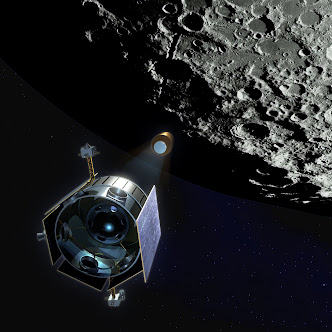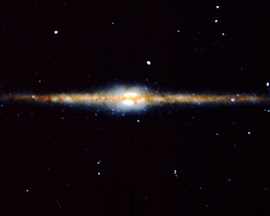A Nebula is a cloud of dust particles, clouds and gases in space. ie Gaseous Nebulae. Classified either as diffuse and planetary Nebulae
A diffuse nebula may occur near an extremely hot, bright star. The intense ultraviolet light from the star energizes the gas atoms of the nebula and enables the mass to emit light.
Astronomers believe some emission nebulae are places where new stars are forming. Gravity causes a portion of a nebula's dust and gases to contract into a much smaller, denser mass. Pressure and temperature build up within the mass of dust and gases as contraction continues for millions of years. In time, the mass becomes hot enough to shine -- and forms a new star.
A diffuse nebula may occur near an extremely hot, bright star. The intense ultraviolet light from the star energizes the gas atoms of the nebula and enables the mass to emit light.
Astronomers believe some emission nebulae are places where new stars are forming. Gravity causes a portion of a nebula's dust and gases to contract into a much smaller, denser mass. Pressure and temperature build up within the mass of dust and gases as contraction continues for millions of years. In time, the mass becomes hot enough to shine -- and forms a new star.

Star Cluster Hodge 301 in the Tarantula Nebulae Enormous stars in the Tarantula Nebula, one of the largest massive star-forming regions close to the Milky Way
********************
Planetary Nebulae: bow tie shape, compose of materials cast off by a dying sun like stars as it enters its white dwarf phase of evolution
********************
********************
NGC 345 in the Small Magellanic Cloud
**********************

Helix Nebulae: The nebula, which is composed of gaseous shells and disks puffed out by a dying sunlike star, exhibits complex structure on even the smallest visible scales.
********************

The Cat's Eye Nebulae shows a bull's eye pattern of eleven or even more concentric rings, or shells, around the Cat's Eye
********************
**********************
 The Cat's Eye Nebulae
The Cat's Eye Nebulae
********************
 The Cone Nebulae: Resembling a nightmarish beast rearing its head from a crimson sea, this monstrous object is actually a pillar of gas and dust. Called the Cone Nebula because of its conical shape in ground-based images, this giant pillar resides in a turbulent star-forming region.
The Cone Nebulae: Resembling a nightmarish beast rearing its head from a crimson sea, this monstrous object is actually a pillar of gas and dust. Called the Cone Nebula because of its conical shape in ground-based images, this giant pillar resides in a turbulent star-forming region.
********************
 The Carina Nebulae are actually molecular clouds, knots of molecular gas and dust so thick they have become opaque
The Carina Nebulae are actually molecular clouds, knots of molecular gas and dust so thick they have become opaque
 The Crab Nebulae is the remnant of a star that was observed to explode in 1054 A.D. It is located 6,000 light years away in the constellation of Taurus, and is a strong source of wavelengths from radio waves through gamma ray waves The center of the Crab Nebula contains a rapidly rotating neutron star -- or pulsar -- that is apparently pumping enormous amounts of energy into the nebula in the form of high-energy particles and magnetic fields.
The Crab Nebulae is the remnant of a star that was observed to explode in 1054 A.D. It is located 6,000 light years away in the constellation of Taurus, and is a strong source of wavelengths from radio waves through gamma ray waves The center of the Crab Nebula contains a rapidly rotating neutron star -- or pulsar -- that is apparently pumping enormous amounts of energy into the nebula in the form of high-energy particles and magnetic fields.
 The Orion Nebulae, turbulent star formation region, More than 3,000 stars of various sizes appear in this image. The Orion Nebula is a picture book of star formation, from the massive, young stars that are shaping the nebula to the pillars of dense gas that may be the homes of budding stars.
The Orion Nebulae, turbulent star formation region, More than 3,000 stars of various sizes appear in this image. The Orion Nebula is a picture book of star formation, from the massive, young stars that are shaping the nebula to the pillars of dense gas that may be the homes of budding stars.
 The Cat's Eye Nebulae
The Cat's Eye Nebulae********************
 The Cone Nebulae: Resembling a nightmarish beast rearing its head from a crimson sea, this monstrous object is actually a pillar of gas and dust. Called the Cone Nebula because of its conical shape in ground-based images, this giant pillar resides in a turbulent star-forming region.
The Cone Nebulae: Resembling a nightmarish beast rearing its head from a crimson sea, this monstrous object is actually a pillar of gas and dust. Called the Cone Nebula because of its conical shape in ground-based images, this giant pillar resides in a turbulent star-forming region.********************
 The Carina Nebulae are actually molecular clouds, knots of molecular gas and dust so thick they have become opaque
The Carina Nebulae are actually molecular clouds, knots of molecular gas and dust so thick they have become opaque********************
 The Crab Nebulae is the remnant of a star that was observed to explode in 1054 A.D. It is located 6,000 light years away in the constellation of Taurus, and is a strong source of wavelengths from radio waves through gamma ray waves The center of the Crab Nebula contains a rapidly rotating neutron star -- or pulsar -- that is apparently pumping enormous amounts of energy into the nebula in the form of high-energy particles and magnetic fields.
The Crab Nebulae is the remnant of a star that was observed to explode in 1054 A.D. It is located 6,000 light years away in the constellation of Taurus, and is a strong source of wavelengths from radio waves through gamma ray waves The center of the Crab Nebula contains a rapidly rotating neutron star -- or pulsar -- that is apparently pumping enormous amounts of energy into the nebula in the form of high-energy particles and magnetic fields. ********************
 The Orion Nebulae, turbulent star formation region, More than 3,000 stars of various sizes appear in this image. The Orion Nebula is a picture book of star formation, from the massive, young stars that are shaping the nebula to the pillars of dense gas that may be the homes of budding stars.
The Orion Nebulae, turbulent star formation region, More than 3,000 stars of various sizes appear in this image. The Orion Nebula is a picture book of star formation, from the massive, young stars that are shaping the nebula to the pillars of dense gas that may be the homes of budding stars. ********************
Pillars of Gas This penetrating view of the central region of the Eagle Nebula reveals how much star formation is happening inside these iconic structures.







